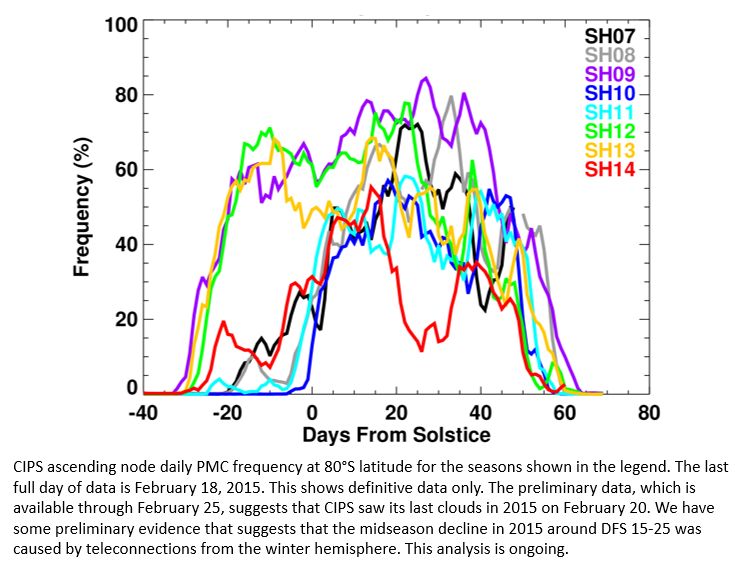Skip to comments.
NOCTILUCENT CLOUDS, BEHAVING STRANGELY
SpaceWeather.com ^
| 1MAR2015
| Staff Writer
Posted on 03/01/2015 8:00:21 AM PST by Jack Hydrazine
The southern season for noctilucent clouds (NLCs) has come to an end. NASA's AIM spacecraft observed the last wisps of electric-blue over Antarctica on Feb. 20, 2015. The end of the season was no surprise: The polar clouds always subside in late summer. Looking back over the entire season, however, reveals something unexpected. In an 8-year plot of Antarctic noctilucent cloud frequencies, the 2014-2015 season is clearly different from the rest:

These data come from the AIM spacecraft, which was launched in 2007 to monitor NLCs from Earth orbit. The curves show the abundance ("frequency") of the clouds vs. time for 120 days around every southern summer solstice for the past 8 years.
"This past season was not like the others," notes Cora Randall, a member of the AIM science team and the chair of the Department of Atmospheric and Oceanic Sciences at the University of Colorado. "The clouds were much more variable, and there was an enormous decrease in cloud frequency 15 to 25 days after the summer solstice. That's when the clouds are usually most abundant."
What does this mean? Previous research shows that NLCs are a sensitive indicator of long-range teleconnections in Earth's atmosphere, which link weather and climate across hemispheres. The strange behavior of noctilucent clouds in 2014-2015 could be a sign of previously unknown linkages. "Preliminary indications are that it is indeed due to inter-hemispheric teleconnections," says Randall. "We're still analyzing the data, so stay tuned."
Now attention turns to the northern hemisphere, where the season for NLCs typically begins in May. Will the northern season ahead be as strangely variable as the southern season, just concluded? Says Randall, "I can't wait to find out."
TOPICS: Miscellaneous; News/Current Events
KEYWORDS: clouds; nlc; noctilucent
Navigation: use the links below to view more comments.
first previous 1-20, 21-35 last
To: BenLurkin
http://www.annualreviews.org/doi/abs/10.1146/annurev-earth-042711-105545
ABSTRACT
Extratropical Cooling, Interhemispheric Thermal Gradients, and Tropical Climate Change
“Recent studies suggest the existence of a global atmospheric teleconnection of extratropical cooling to the tropical rainfall climate, mediated through the development of a thermal contrast between the hemispheres—an interhemispheric thermal gradient. This teleconnection has been largely motivated by studies that show a global synchronization of rapid climate change during abrupt climate changes of the last glacial period, in addition to attribution studies of twentieth-century Sahel drought and studies that examined the climate impacts of anthropogenic aerosols. This research has led to interesting developments in atmospheric dynamics of the underlying mechanisms and in applications toward understanding past and present tropical climate change. The emerging teleconnection hypothesis promises to offer new insights into understanding future patterns of tropical rainfall changes due to inter-hemispheric thermal gradients from greenhouse warming, aerosols, and land-use change.”
When did each hemisphere get the ability to make phone calls to one another?
It’s still man’s fault whatever the strangeness in the NLCs!
21
posted on
03/01/2015 9:03:31 AM PST
by
Jack Hydrazine
(Pubbies = national collectivists; Dems = international collectivists; We need a second party!)
To: Starstruck
I’m finding the closest cave!
22
posted on
03/01/2015 9:04:16 AM PST
by
Jack Hydrazine
(Pubbies = national collectivists; Dems = international collectivists; We need a second party!)
To: Fungi
A spokeshave is a tool used to shape and smooth wooden rods and shafts - often for use as wheel spokes, chair legs (particularly complex shapes such as the cabriole leg), self bows, and arrows. It can also be used to carve canoe or kayak paddles

similar tool used for preparing hides for tanning....

23
posted on
03/01/2015 9:04:23 AM PST
by
spokeshave
(He has erected a multitude of New Offices, and sent hither swarms of Officers to harass our people,)
To: Jack Hydrazine
My question is do they reflect outgoing IR as cirrus clouds do?
24
posted on
03/01/2015 9:04:49 AM PST
by
Bulwinkle
(Alec, a.k.a. Daffy Duck)
To: Bulwinkle
They are made of water so, yes, they do.
25
posted on
03/01/2015 9:06:04 AM PST
by
Jack Hydrazine
(Pubbies = national collectivists; Dems = international collectivists; We need a second party!)
To: spokeshave
Yes, now that I think about it, I remember that tool in a woodworking clas. Thank you,
26
posted on
03/01/2015 9:19:46 AM PST
by
Fungi
(Evolution is piece by piece over billions of years. At what point did a precursor become a human?)
To: Texas Eagle
I always remembered this one:

27
posted on
03/01/2015 9:24:52 AM PST
by
dr_lew
To: OldNukeDaddy
Do they actually have more than 8 years of data to make the claim that the most recent year is “strange”? That is a good question. Looking at the overall variability of the year-to-year data, one must conclude that 2014 departs as much from the rest as 2009 did when all they had was 2007 and 2008 data; they would have concluded that the clouds started super early in 2009, clearly indicating the end of the world due to noctilucent cloud chaos. Also, 2010 and 2011 show a similar pattern as 2014 but just somewhat less pronounced. So they are just pointing out extremes in a very small data set with the subconscious intent to keep the research funds flowing for what seems to be a very esoteric corner of science.
To: Jack Hydrazine
29
posted on
03/01/2015 9:33:02 AM PST
by
Bulwinkle
(Alec, a.k.a. Daffy Duck)
To: Bulwinkle
Hmmmm...very strange. Thanks for the link!
30
posted on
03/01/2015 9:34:50 AM PST
by
Jack Hydrazine
(Pubbies = national collectivists; Dems = international collectivists; We need a second party!)
To: spokeshave
I think there is a huge sunspot heading Europe’s way. Supposed to hit March 2 or 3.
To: Fresh Wind
To: Jack Hydrazine
33
posted on
03/01/2015 12:39:54 PM PST
by
Kenton
To: Bulwinkle
To: Texas Eagle
“School started early back in those days. You’re probably too young to remember. Plus, sometimes we’d wear sunglasses.”
Mostly form in the summer. And not seen in the U.S. except Alaska.
Navigation: use the links below to view more comments.
first previous 1-20, 21-35 last
Disclaimer:
Opinions posted on Free Republic are those of the individual
posters and do not necessarily represent the opinion of Free Republic or its
management. All materials posted herein are protected by copyright law and the
exemption for fair use of copyrighted works.
FreeRepublic.com is powered by software copyright 2000-2008 John Robinson




